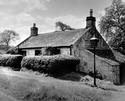 The Forth and Clyde Canal had little utilisation by the 1950s and a campaign to close it gathered pace as successive government reports highlighted its commercial decline. It was however still being used by fishing boats from the east coast, changing grounds to the west. On their way back and forth they gave lock and bridge keepers free fish. Sometimes they sold their catches to canal-side communities and children helped the men work the lock gates - they got some fish too. But this activity failed to impress those in authority and the canal was closed to navigation on 1 January 1963. It sank rapidly into decay and dereliction, as the Monkland Canal had done before it, causing a danger to children. Some drowned in the weedy, deserted waters.
The Forth and Clyde Canal had little utilisation by the 1950s and a campaign to close it gathered pace as successive government reports highlighted its commercial decline. It was however still being used by fishing boats from the east coast, changing grounds to the west. On their way back and forth they gave lock and bridge keepers free fish. Sometimes they sold their catches to canal-side communities and children helped the men work the lock gates - they got some fish too. But this activity failed to impress those in authority and the canal was closed to navigation on 1 January 1963. It sank rapidly into decay and dereliction, as the Monkland Canal had done before it, causing a danger to children. Some drowned in the weedy, deserted waters.
 Some bridges were culverted (i.e. the canal water was channelled through a tunnel beneath the road). In the 1960s and 70s large culverts were put in at Port Dundas and Blairdardie. The Monkland Canal was culverted from Port Dundas to Easterhouse to make way for the M8 and another motorway was planned to replace the Forth and Clyde from Port Dundas to Maryhill. It was never made, but while people argued over it, other campaigners began to press for the canal to be reinstated. Boats reappeared at small rally events at Maryhill and Temple. In the 1980s the local authorities drew up a revival plan and the dereliction began to be reversed. British Waterways continued the process with a scheme called The Millennium Link which reopened navigation in May 2001 - the canal had made a remarkable comeback.
Some bridges were culverted (i.e. the canal water was channelled through a tunnel beneath the road). In the 1960s and 70s large culverts were put in at Port Dundas and Blairdardie. The Monkland Canal was culverted from Port Dundas to Easterhouse to make way for the M8 and another motorway was planned to replace the Forth and Clyde from Port Dundas to Maryhill. It was never made, but while people argued over it, other campaigners began to press for the canal to be reinstated. Boats reappeared at small rally events at Maryhill and Temple. In the 1980s the local authorities drew up a revival plan and the dereliction began to be reversed. British Waterways continued the process with a scheme called The Millennium Link which reopened navigation in May 2001 - the canal had made a remarkable comeback.